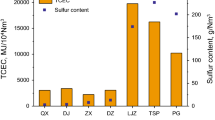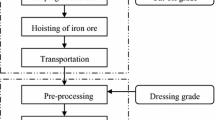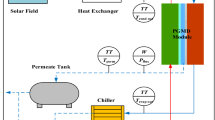Abstract
There are few methods of semi-autogenous (SAG) mill power prediction in the full-scale without using long experiments. In this work, the effects of different operating parameters such as feed moisture, mass flowrate, mill load cell mass, SAG mill solid percentage, inlet and outlet water to the SAG mill and work index are studied. A total number of 185 full-scale SAG mill works are utilized to develop the artificial neural network (ANN) and the hybrid of ANN and genetic algorithm (GANN) models with relations of input and output data in the full-scale. The results show that the GANN model is more efficient than the ANN model in predicting SAG mill power. The sensitivity analysis was also performed to determine the most effective input parameters on SAG mill power. The sensitivity analysis of the GANN model shows that the work index, inlet water to the SAG mill, mill load cell weight, SAG mill solid percentage, mass flowrate and feed moisture have a direct relationship with mill power, while outlet water to the SAG mill has an inverse relationship with mill power. The results show that the GANN model could be useful to evaluate a good output to changes in input operation parameters.
摘要
一般全面预测半自磨机功率的方法都需要经过长期实验。 本文研究不同的操作参数对磨机和工作指数的影响, 如供给水分、 质量流速、 磨机荷重计自重、 固含率、 进口和出口水流量。 测试 185 个全面的半自磨机功率, 用于开发与输入和输出数据有关的人工神经网络和的混合遗传算法模型。 在预测半自磨机功率上, 混合遗传算法模型比人工神经网络更高效。 敏感性分析确定了半自磨机功率预测最高效的输入参数。 通过混合遗传算法模型的敏感性分析发现, 工作指数、 磨机入口水、 磨机荷重计自重、 固含率、 质量流速和供给水分与磨机功率有直接关系, 而出口水与磨机功率负相关。 结果表明, 混合遗传算法模型能用于评价输入操作参数变化导致的输出。
Similar content being viewed by others
References
SALAZAR J, MAGNE L, ACUNA G, CUBILLOS F. Dynamic modelling and simulation of semi-autogenous mills [J]. Minerals Engineering, 2009, 22(1): 70–77.
MORRELL S. A method for predicting the specific energy requirement of comminution circuits and assessing their energy utilisation efficiency [J]. Minerals Engineering, 2008, 21(3): 224–233.
MORRELL S. A new autogenous and semi-autogenous mill model for scale-up, design and optimisation [J]. Minerals Engineering, 2004, 17(3): 437–345.
VAN NIEROP M, MOYS M. The effect of overloading and premature centrifuging on the power of an autogenous mill [J]. Journal of the South African Institute of Mining and Metallurgy, 1997, 97(7): 313–317.
HERBST J, PATE W. Object components for comminution system softsensor design [J]. Powder Technology, 1999, 105(1): 424–429.
NAPIER-MUNN T J, MORRELL S, MORRISON R D, KOJOVIC T. Mineral comminution circuits: Their operation and optimisation [M]. Brisbare: Julius Kruttschnitt Mineral Research Centre, University of Queensland, 1996: 413.
VALERY W, MORRELL S. The development of a dynamic model for autogenous and semi-autogenous grinding [J]. Minerals Engineering, 1995, 8(11): 1285–1297.
APELT T, ASPREY S, THORNHILL N. Inferential measurement of SAG mill parameters [J]. Minerals Engineering, 2001, 14(6): 575–591.
CHELGANI S C, SHAHBAZI B, REZAI B. Estimation of froth flotation recovery and collision probability based on operational parameters using an artificial neural network [J]. International Journal of Minerals, Metallurgy, and Materials, 2010, 17(5): 526–534.
AMNIEH H B, SIAMAKI A, SOLTANI S. Design of blasting pattern in proportion to the peak particle velocity (PPV): Artificial neural networks approach [J]. Safety Science, 2012, 50(9): 1913–1916.
KHANDELWAL M, SINGH T. Prediction of blast-induced ground vibration using artificial neural network [J]. International Journal of Rock Mechanics and Mining Sciences, 2009, 46(7): 1214–1222.
PATTERSON D W. Artificial neural networks: Theory and applications [M]. Prentice Hall PTR, 1998: 477.
EBERHART R C. Neural network PC tools: A practical guide [M]. Academic Press, 2014: 440.
VOSE M D. The simple genetic algorithm: Foundations and theory [M]. MIT press, 1999: 251.
SHOPOVA E G, VAKLIEVA-BANCHEVA N G. BASIC—A genetic algorithm for engineering problems solution [J]. Computers & Chemical Engineering, 2006, 30(8): 1293–1309.
YASIN Y, AHMAD F B H, GHAFFARI-MOGHADDAM M, KHAJEH M. Application of a hybrid artificial neural network–genetic algorithm approach to optimize the lead ions removal from aqueous solutions using intercalated tartrate-Mg–Al layered double hydroxides [J]. Environmental Nanotechnology, Monitoring & Management, 2014, 1: 2–7.
GUPTA J N, SEXTON R S. Comparing backpropagation with a genetic algorithm for neural network training [J]. Omega, 1999, 27(6): 679–684.
LI C Q, YANG Z X, YAN H Y, WANG T. The application and research of the ga-bp neural network algorithm in the mbr membrane fouling [J]. Abstract and Applied Analysis: Hindawi Publishing Corporation, 2014, Article ID: 673156.
MARTÍNEZ-MORALES J D, PALACIOS-HERNÁNDEZ E R, VELÁZQUEZ-CARRILLO G A. Artificial neural network based on genetic algorithm for emissions prediction of a SI gasoline engine [J]. Journal of Mechanical Science and Technology, 2014, 28(6): 2417–2427.
Author information
Authors and Affiliations
Corresponding author
Rights and permissions
About this article
Cite this article
Hoseinian, F.S., Abdollahzadeh, A. & Rezai, B. Semi-autogenous mill power prediction by a hybrid neural genetic algorithm. J. Cent. South Univ. 25, 151–158 (2018). https://doi.org/10.1007/s11771-018-3725-8
Received:
Accepted:
Published:
Issue Date:
DOI: https://doi.org/10.1007/s11771-018-3725-8
Key words
- semi-autogenous mill
- mill power
- prediction
- sensitivity analysis
- artificial neural network
- genetic algorithm




